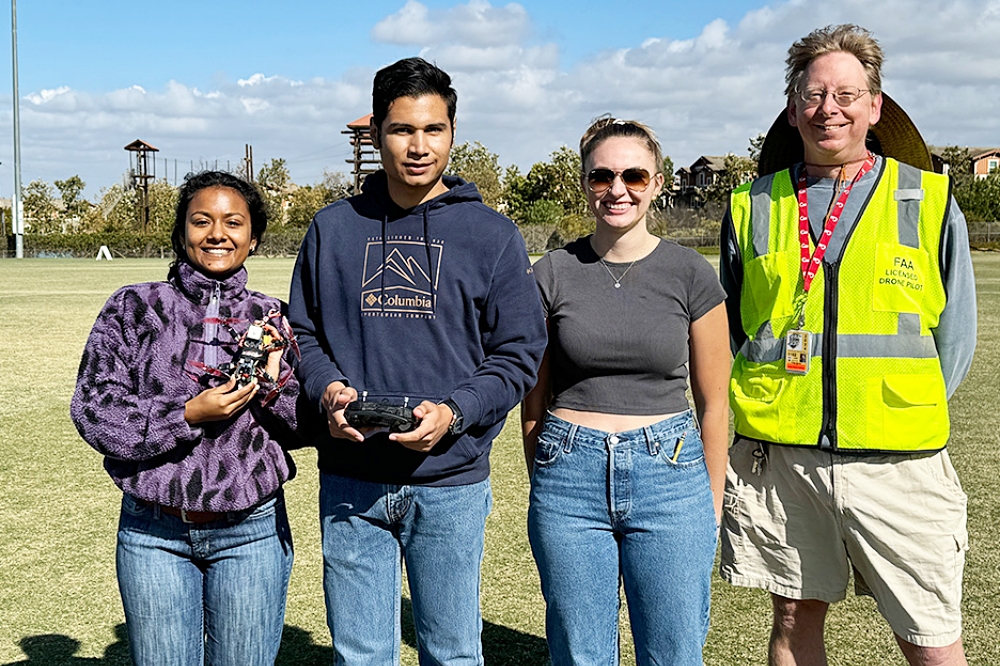UCI Professor Peter Burke set a Guinness World Record* for the farthest distance to control a drone. Now, the electrical engineering professor is teaching a class where students get to build and fly that exact drone model.
His record-breaking drone was operated from 11,440 miles away – close to antipode, the furthest distance on the planet – at Réunion, a tiny French island in the Indian Ocean. Burke achieved the milestone by controlling the UAV through the internet rather than by radio signals, the way most commercial drones are flown.
Now he’s passing on this cutting-edge drone technology to his students. Burke’s new class (EECS 195) is giving 77 engineering students the chance to build, program and fly an internet-controlled drone that weighs under 250 grams.
“These are tiny drones,” said Burke, “but it’s the same electronics as the big drones used in industry. What they learn can be applied to any-sized drone.”
He notes their UAVs have the exact same software and hardware as a hundred-thousand-pound drone a former student of his now operates at a Bay Area startup.
In Burke’s class, the students form teams of three that solder, wire, assemble and program their drones. They also learn FAA regulations, safety protocols and theory of how the components work including the GPS, electric motors, batteries (the same batteries that EVs use), radio propagation and more.
“We’ve had a great time building the drones,” said computer science engineering senior Aiden Dodge. “It’s a great way to apply everything we’ve learned up until this point into a real physical project.”
“My dad is a pilot,” said electrical engineering senior Catherine Riker. “One of the cool perks of this class is that we actually get an FAA license, which I can show off to my dad.”
Many students love the hands-on aspect of the class. “I really like soldering – it’s really cool,” said electrical engineering senior Antara Kundu, who recently interned on an aircraft carrier and wants to work in the defense industry.
“I love Professor Burke. He is so nice and willing to help. He wants everyone to succeed.”
Burke’s grading system is simple: teams who build the drone get a C; if it flies, they get a B; and if it succeeds in flying and returning through a pre-programmed flight path, they’ll get an A. Burke believes all of them will succeed.
Riker was ecstatic when their drone aced the final mission. “We were able to fly it manually and it successfully flew to its waypoints and returned home so we got an A+!”
Through this class, Burke is transferring cutting-edge know-how to future engineers. If more UAVs can be controlled over the internet, it could have endless applications including search and rescue operations, ocean, forest and land surveying and much more.

From left: Engineering students Antara Kundu, Ricardo Martinez and Catherine Riker with Professor Peter Burke
This technology can also make drones safer and more useful. Current technology doesn’t enable drones to fly in the national air space system as the UAVs need to be in one’s line of sight – a far cry from Burke’s drone operation capabilities.
“Because the drone is connected and controlled through the internet, its range is practically infinite,” said Burke.
Getting drones on the internet is also a way to avoid collision. Burke and his students are working on more ways to make drones safer. But for now, in his novel class, Burke is happy seeing the smiles on students’ faces when their
Top Photo: From left: Computer science engineering senior Aiden Dodge, Professor Peter Burke and teaching assistant Patrick Rwei watch Dodge’s drone fly.
Source: UCI Samueli School of Engineering
* Footnote:
UCI’s Peter Burke and French colleague Patrick Jeanty earned a Guinness World Record for their demonstration of remotely flying a drone through the internet from halfway around the world.
The official Guinness citation reads, “the farthest distance to control a commercially available Unmanned Aerial Vehicle (UAV) at 18,411 kilometers (11,440 miles).”
For comparison, the maximum distance between two points on earth is about 12,450 miles.



